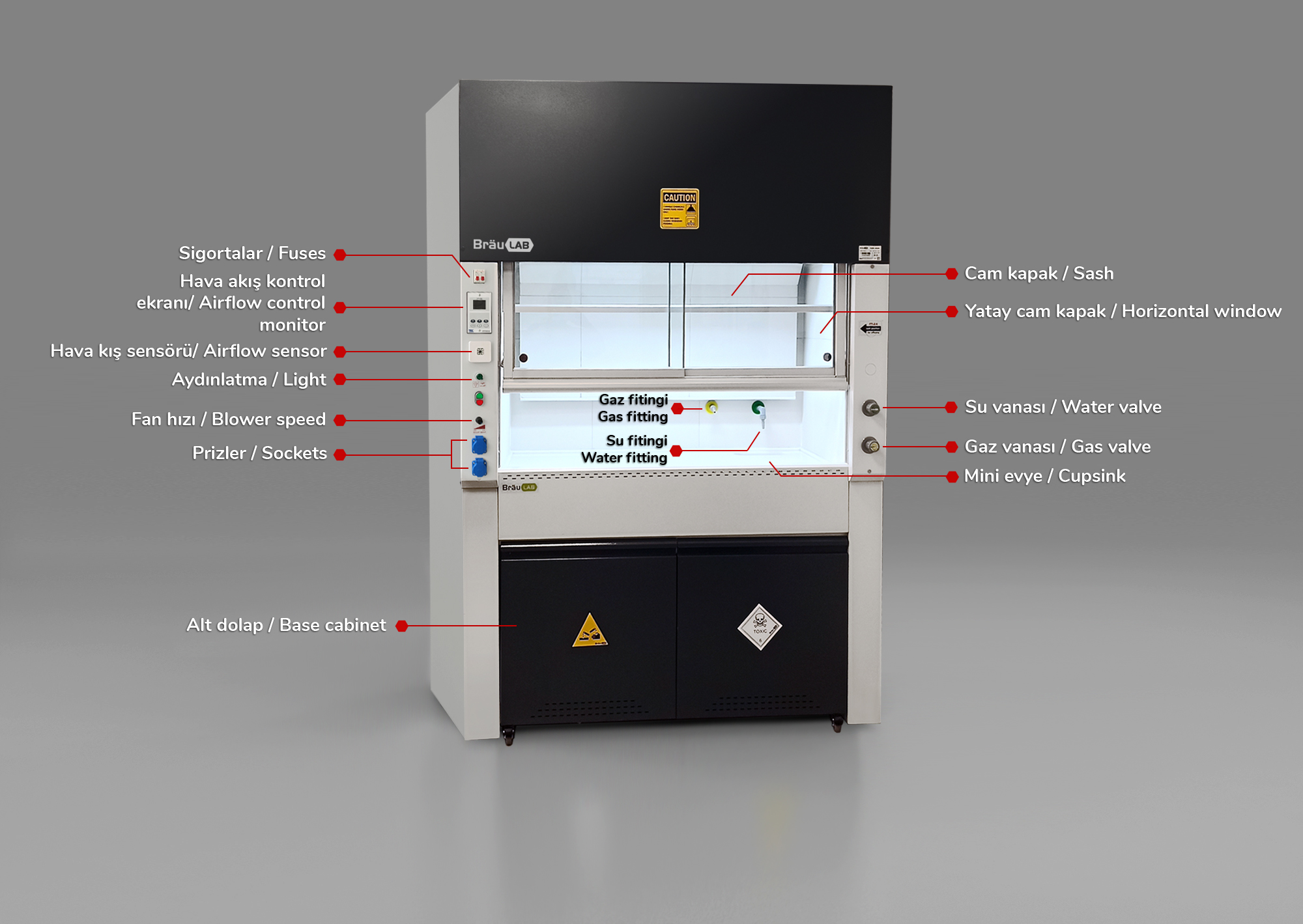
Contaminating particles that can be suspended in the air usually cause respiratory damage. With the inhaled air, these chemicals can enter the lungs and from there into the bloodstream and spread throughout the body. In order to identify and prevent hazards that may occur before or after working in the laboratory, or to minimize the possibility of occurrence, safe working conditions for human health should be provided based on scientific methods. Fume hood or fume cupboard is a device that provides all kinds of work done with chemicals (analysis, experiment etc.) in laboratory environments safely. BRAU GROUP designs and produces fume hoods in various models for a better laboratory working environment.
Fume hood mainly consists of 4 parts.

Ventilation fan motor, exhaust air connection, lighting, sash lifting system etc. are located in the upper part. In the working area, there is a glass sash, cupsink that changes according to the model, other analytical gas fittings and worktop. In the control panels section, depending on the model, there are generally electrical sockets, blower and lighting control switches and valves for mechanical installations.
The most important and first thing to consider when buying a fume hood is whether the device is manufactured in accordance with EN 14175 standard. It must be ensured that the fume cupboard is manufactured to this standard. This should be documented and one-to-one air flow tests should be performed on the device you purchased. Devices that do not have air flow dynamics adjusted in accordance with TS EN 14175 standard will have serious leakages and poor performance, thus reducing the protection of the device and may not even have any protective properties.
Another issue to be considered when buying fume hoods is the choice of models and features. Here, it is necessary to determine for what purpose it is used, what chemicals or devices to use with them. Otherwise, a fume hood with standard features to be taken into memory can be scrapped for a month with the chemicals you will use. Or, since the device needs to be made in special sizes, it can be dysfunctional. Do not waste your money by making a wrong choice. Be sure to contact BrauLAB officials about these issues.
Another subject will be the choice of place. Wherever you will install your fume hood, the dimensions of the area should be taken and it should be checked whether it is suitable for the necessary plumbing, electrical and air duct connections. Especially the height of the ceiling is a neglected issue that prevents installation. Be sure to contact BrauLAB officials before installations.
Fume Cupboards should be placed away from indoor air conditioning systems, doors and windows, and where human traffic is minimal. Fume hood must be made of water, moisture and chemical resistant material. Fume hood ventilation system must be capable of providing continuous air flow and can work 24 hours. Electrical installations and equipment and mechanical installations and equipment must be isolated from each other. Electrical outlets and switches must be outside the fume cupboard work area.
The reason for human errors is lack of information and carelessness. A list of chemicals to be used in the fume cupboard and MSDS (material safety) forms related to them should be kept in the closest accessible location. Despite all the precautions taken, an accident that may occur in the laboratory environment should be taken into consideration and a first aid team should be available in the institution.
Corrosive and / or carcinogenic substances such as mercury, nitric acid, sulfuric acid, hydrochloric acid, sodium hydroxide, potassium hydroxide, carbon tetra chloride etc. must be used when working with or. The fume cupboard must be absolutely connected to a grounding conductor. The ventilation fan must be activated before the fume hood front sash is opened. The sash should be lowered to the lowest possible level during operations in the fume hood. In this way, the user will be under protection as a result of events such as explosions, flames, splashes etc. that may occur inside. However, users should wear extra protective lab glasses. During operation, fume cupboard sash should not be raised more than 50 cm. Otherwise, the gases emitted will leak out of the cabin since the suction power will decrease.
For burns that may occur during working with sodium hydroxide, Potassium hydroxide, Calciumhydroxide and similar substances, an emergency eye shower, 1% boric acid and 5% acetic acid should be kept appropriately available. Before working explosive and flammable chemicals in the fume hood, electrical devices that you should use must be turned on first of all. When working in the fume hood, all materials should be placed at least 15 cm away from the front sash.
When working with a water bath, the water level should be checked frequently and if low, should be completed with distilled water. When working with the tool, attention should be paid to steam; suitable protective equipment should be used. The water bath should be turned off after the operation is completed. Before working with the distillation sets, it should be ensured that the cooling water is turned on due to the risk of explosion before the distillation process. During distillation, it should be checked whether the coolant overheats. After the distillation process is finished, the water valve should not be closed before the cooling device cools down.